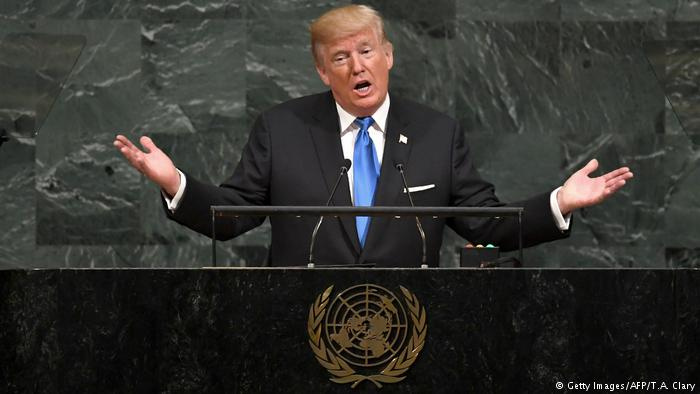For as Long as Europe Trusts Iran, Washington is Alone

US President Donald Trump still insists that the nuclear deal with Iran is the worst accord possible and is looking for a way out of it, despite the verification of Iran’s commitment by the International Atomic Energy Agency and the world powers. Trump is expected to announce his final decision on the deal in October.
American decision-makers seem to have adopted a new strategy vis-à-vis Iran’s regional policies. The new strategy does not target the deal directly, but rather tries to cast suspicion on the deal among its European advocates. The new strategy, brokered by Secretary of Defense James Mattis, Secretary of State Rex Tillerson, and National Security Advisor Herbert McMaster et al. was proposed to the National Security Council on September 8. Two of the officials have told media outlets that the strategy will go public by the end of September in case of the President’s approval.
The strategy could be dubbed a 'network strategy' to control Iran because it is designed to put Iran under pressure from different angles. Using the new tactic, the US is in fact trying to prove that Iran is violating the spirit of the deal outside the country, so to convince the Congress to walk out. The notion is caused by the Trump team’s failure to press Iran by the deal itself. On the other hand, Iran has remained fully faithful to its commitments under the nuclear accord, earning endorsements from the IAEA. In propelling its strategy, the US has modulated its executive tactic of controlling Iran under violation of the deal to a 'control network' targeting Iran’s regional policies.
Spirit of the deal apparently refers to a series of military and non-military operations undertaken by Iran in the region, introducing a completely different facet of the country, which attests to Iran’s role in almost every regional affairs. On the other hand, Iran’s commitment to the deal has successfully built trust with the world, making the Chancellor of the strongest EU economy Angela Merkel cite the JCPOA as an example to follow in order to curb North Korea’s missile program. EU Spokeswoman Federica Mogherini has repeatedly reiterated the signatories’ commitment to the deal after US President’s constant criticisms. These have led to the shift in the US policies vis-à-vis Iran.
The new tactic is aimed to increase pressure on Tehran to leash its ballistic missiles program, its support for militias in the region and its alleged cyber-espionage. From the US’ point of view, Iran’s intentions in the region include financing and supporting terrorism and destabilizing the region, particularly in Iraq, Syria, and Yemen.
Let us review US’ approach in the network strategy and tactics it probably will use against Iran in peripheral regions. The strategy could be implemented with specific techniques and means peculiar to each region. The core of the new strategy is to contain Iran’s operational space in the region and revoke the nuclear deal to isolate Iran from the global community. The new strategy includes various tactics against Iran, both multifaceted and interconnected. The tactic’s operational regions include:
The Syrian Crisis: In unison with Syria’s central government in the country’s civil war, Iran had a pivotal role in the fight against ISIS. The US tries to accuse groups affiliated with Iran and downplay the country’s role in ISIS elimination, in order to be able to label the country as a sponsor of terror.
Shia Iran’s role in Iraq: Iranian pilgrims’ rush to Iraq and Tehran’s role in the establishment of the Shiite government in Iraq are not secrets. The US sees the need to meet Iran’s demands before being able to propel its operational strategies in Iraq. Thus, the US tries to contain Iran’s operational domain through accusations of intervention and violation of Baghdad’s executive sovereignty. The superpower seeks to challenge Iran’s status by causing sociopolitical deadlocks.
Yemen: To the US, Saudi Arabia’s evident carnage in Yemen is an issue of cooperation among Arab states and a means to boost Saudis’ regional power, in order to secure the balance of Sunni powers against Shia states led by Iran.
Qatar: Qatar’s advocacy of political division with Persian Gulf Sunni states which puts Iran in a more powerful position by questioning Riyadh’s policies is disturbing for Saudi Arabia. The US, an ally to the wealthy Arab state, cannot stand Iran’s growing influence.
Bahrain: Iran’s involvement in Bahrain is a matter of identity and undeniable. Bahrain’s Shiite population and sociopolitical constraints imposed by the rulers is another issue the US will seek to address to hamper Iran’s influence.
Russia: Iran’s strategic alliance with Russia is one of Iran’s most challenging tools for peripheral involvement. Thus, US sees itself obliged to choose between an accord with Russia to end its cooperation with Iran or to accept the status quo. The latter is a deal-maker both Iran and Russia could use in talks with the US.
These interconnected tactics will not bear fruit because Iran is fully committed to the deal, already having hard-won trust in Europe, which will not be lost that easily. In line with its motto of cooperation with the world, Iran’s diplomatic team move quite cautiously in the region, also using Russia, as a strategic ally. The Iranian side already seems to be intelligently forestalling the US’ strategy. An evident example could be prospect of improvements in ties with Saudi Arabia. Therefore, it could be concluded that the US’ network strategy will not work and the superpower should find another alternative to prove Iran’s violation of the spirit of the nuclear deal.

